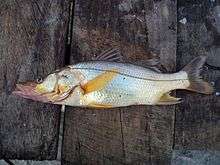Centropomus parallelus
| Centropomus parallelus | |
|---|---|
 | |
| Scientific classification | |
| Kingdom: | Animalia |
| Phylum: | Chordata |
| Class: | Actinopterygii |
| Order: | Perciformes |
| Family: | Centropomidae |
| Genus: | Centropomus |
| Species: | C. parallelus |
| Binomial name | |
| Centropomus parallelus Poey, 1860 | |
Centropomus parallelus is a species of fish in the family Centropomidae, the snooks and robalos. It is known by several common names, including fat snook, smallscale fat snook, little snook, and chucumite.[1] It is native to the western Atlantic Ocean and Gulf of Mexico, its distribution extending from southern Florida in the United States to southern Brazil near Florianópolis.[2]
Description
This fish is generally up to 25 centimeters long, but it has been known to reach 72 centimeters. The maximum published weight is 5 kilograms.[2] Like other snooks it has a large head with a long, pointed snout and large, laterally positioned eyes. The large mouth has bands of villiform teeth. The body is yellowish brown to brownish green in color. It has a silvery sheen on the sides and belly and a dark line along the lateral line.[3]
Biology

This fish can tolerate a wide range of salinities and can be found in fresh, brackish, and marine waters. It can venture into high-salinity lagoons. It lives in many kinds of coastal habitat and is most often seen in fresh and mildly brackish water habitat types.[2]
This species is a carnivore with crustaceans making up a large part of its diet.[4] In experimental conditions fat snook feed during the day but during times of lower light, in the early morning and late afternoon.[5]
Aquaculture
This species is caught and sold as a food fish. Because of its market value it is studied for its potential as a farmed fish in the aquaculture industry. It is easy to rear in captivity, it can be raised on fish food rather than live prey, and it has a good feed conversion ratio, efficiently turning feed into meat.[6] So far researchers have achieved "massive production of juveniles" in the laboratory, and viable methods for commercial production are being studied.[7] In one successful trial, fat snook were grown from eggs placed in a substrate of Nannochloropsis algae, and the larvae that hatched were reared on a diet of rotifers and brine shrimp larvae. They were then "weaned" to a high-protein dry diet.[8]
Because it is a euryhaline fish, living in marine, brackish, and freshwater habitats, it can be farmed in a wide range of salinities.[9]
This species is protandrous, the form of sequential hermaphroditism in which males change to the female sex as they grow.[10] Females grow better than males, yielding more output. Researchers have experimented with dosing tanks of fish with the female sex hormone estradiol to produce all-female stocks, with promising results.[6]
References
- ↑ Froese, R. and D. Pauly, eds. Common names of Centropomus parallelus. FishBase. 2014.
- 1 2 3 Froese, R. and D. Pauly, eds. Centropomus parallelus. FishBase. 2014.
- ↑ McEachran, J. D. and J. D. Fechhelm. Fishes of the Gulf of Mexico, Volume 2: Scorpaeniformes to Tetraodontiformes. University of Texas Press. 2006. pp 97 and 101.
- ↑ Contente, R. F., et al. (2009). Size-related shifts in dietary composition of Centropomus parallelus (Perciformes: Centropomidae) in an estuarine ecosystem of the southeastern coast of Brazil. Journal of Applied Ichthyology 25(3) 335–42.
- ↑ Tsuzuki, M. Y., et al. (2008). Growth of juvenile fat snook Centropomus parallelus in cages at three stocking densities. B. Inst. Pesca, São Paulo, 34(2) 319-24.
- 1 2 de Carvalho, C. V. A., et al. (2014). Feminization and growth of juvenile fat snook Centropomus parallelus fed diets with different concentrations of estradiol-17β. Aquaculture International 22 1391-1401.
- ↑ Tsuzuki, M. Y., et al. (2007). Salinity tolerance of laboratory reared juveniles of the fat snook Centropomus parallelus. Brazilian Journal of Oceanography 55(1) 1-5.
- ↑ Alvarez-Lajonchegre, L., et al. (2002). Mass production of juveniles of the fat snook Centropomus parallelus in Brazil. Journal of the World Aquaculture Society 33(4) 506–16.
- ↑ Medeiros, L. S., et al. Ammonia excretion in fat snook (Centropomus parallelus Poey, 1860) at different salinities. Aquaculture Research epub ahead of print, April 2, 2014.
- ↑ Crain, B. J. and W. A. Gould. 2012 (Draft). Fat snook (Centropomus parallelus) – species natural history in Puerto Rico and the U.S. Virgin Islands. IITF-SR-##. Río Piedras, Puerto Rico: USDA Forest Service, International Institute of Tropical Forestry.
Further reading
- Oss, R. N., et al. (2013). Recovery of fat snook, Centropomus parallelus (Teleostei: Perciformes) after subchronic exposure to copper. Comparative Biochemistry and Physiology Part C: Toxicology & Pharmacology 157(3) 306-09.
- Tondolo, J. S. M., et al. (2013). Anesthesia and transport of fat snook Centropomus parallelus with the essential oil of Nectandra megapotamica (Spreng.) Mez. Neotropical Ichthyology 11(3) 667-74.